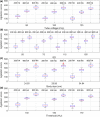Optimization of HU threshold for coronary artery calcium scans reconstructed at 0.5-mm slice thickness using iterative reconstruction
- PMID: 31889419
- PMCID: PMC7021007
- DOI: 10.1002/acm2.12806
Optimization of HU threshold for coronary artery calcium scans reconstructed at 0.5-mm slice thickness using iterative reconstruction
Abstract
Purpose: This work investigated the simultaneous influence of tube voltage, tube current, body size, and HU threshold on calcium scoring reconstructed at 0.5-mm slice thickness using iterative reconstruction (IR) through multivariate analysis. Regression results were used to optimize the HU threshold to calibrate the resulting Agatston scores to be consistent with those obtained from the conventional protocol.
Methods: A thorax phantom set simulating three different body sizes was used in this study. A total of 14 coronary artery calcium (CAC) protocols were studied, including 1 conventional protocol reconstructed at 3-mm slice thickness, 1 FBP protocol, and 12 statistical IR protocols (3 kVp values*4 SD values) reconstructed at 0.5-mm slice thickness. Three HU thresholds were applied for calcium identification, including 130, 150, and 170 HU. A multiple linear regression method was used to analyze the impact of kVp, SD, body size, and HU threshold on the Agatston scores of three calcification densities for IR-reconstructed CAC scans acquired with 0.5-mm slice thickness.
Results: Each regression relationship has R2 larger than 0.80, indicating a good fit to the data. Based on the regression models, the HU thresholds as a function of SD estimated to ensure the quantification accuracy of calcium scores for 120-, 100-, and 80-kVp CAC scans reconstructed at 0.5-mm slice thickness using IR for three different body sizes were proposed. Our results indicate that the HU threshold should be adjusted according to the imaging condition, whereas a 130-HU threshold is appropriate for 120-kVp CAC scans acquired with SD = 55 for body size of 24.5 cm.
Conclusion: The optimized HU thresholds were proposed for CAC scans reconstructed at 0.5-mm slice thickness using IR. Our study results may provide a potential strategy to improve the reliability of calcium scoring by reducing partial volume effect while keeping radiation dose as low as reasonably achievable.
Keywords: Agatston score; coronary artery calcification; iterative reconstruction; protocol optimization.
© 2019 The Authors. Journal of Applied Clinical Medical Physics published by Wiley Periodicals, Inc. on behalf of American Association of Physicists in Medicine.
Conflict of interest statement
The authors have no relevant conflicts of interest to disclose.
Figures






Similar articles
-
Determining the radiation dose reduction potential for coronary calcium scanning with computed tomography: an anthropomorphic phantom study comparing filtered backprojection and the adaptive iterative dose reduction algorithm for image reconstruction.Invest Radiol. 2013 Dec;48(12):857-62. doi: 10.1097/RLI.0b013e31829e3932. Invest Radiol. 2013. PMID: 23917328
-
Very low-dose coronary artery calcium scanning with high-pitch spiral acquisition mode: comparison between 120-kV and 100-kV tube voltage protocols.J Cardiovasc Comput Tomogr. 2013 Jan-Feb;7(1):32-8. doi: 10.1016/j.jcct.2012.11.004. Epub 2012 Dec 1. J Cardiovasc Comput Tomogr. 2013. PMID: 23333186
-
Assessment of Coronary Artery Calcium on Low-Dose Coronary Computed Tomography Angiography With Iterative Reconstruction.J Comput Assist Tomogr. 2016 Mar-Apr;40(2):266-71. doi: 10.1097/RCT.0000000000000347. J Comput Assist Tomogr. 2016. PMID: 26720203
-
Controversies about effects of low-kilovoltage MDCT acquisition on Agatston calcium scoring.J Cardiovasc Comput Tomogr. 2013 Jan-Feb;7(1):58-61. doi: 10.1016/j.jcct.2012.11.006. Epub 2012 Dec 4. J Cardiovasc Comput Tomogr. 2013. PMID: 23333185
-
Scoring of coronary artery calcium scans: history, assumptions, current limitations, and future directions.Atherosclerosis. 2015 Mar;239(1):109-17. doi: 10.1016/j.atherosclerosis.2014.12.040. Epub 2015 Jan 2. Atherosclerosis. 2015. PMID: 25585030 Review.
Cited by
-
Evolving Role of Calcium Density in Coronary Artery Calcium Scoring and Atherosclerotic Cardiovascular Disease Risk.JACC Cardiovasc Imaging. 2022 Sep;15(9):1648-1662. doi: 10.1016/j.jcmg.2022.02.026. Epub 2022 May 11. JACC Cardiovasc Imaging. 2022. PMID: 35861969 Free PMC article. Review.
-
Coronary artery calcium mass measurement based on integrated intensity and volume fraction techniques.J Med Imaging (Bellingham). 2023 Jul;10(4):043502. doi: 10.1117/1.JMI.10.4.043502. Epub 2023 Jul 10. J Med Imaging (Bellingham). 2023. PMID: 37434664 Free PMC article.
References
-
- Pletcher MJ, Tice JA, Pignone M, Browner WS. Using the coronary artery calcium score to predict coronary heart disease events: a systematic review and meta‐analysis. Arch Intern Med. 2004;164:1285–1292. - PubMed
-
- Arad Y, Spadaro LA, Goodman K, Newstein D, Guerci AD. Prediction of coronary events with electron beam computed tomography. J Am Coll Cardiol. 2000;36:1253–1260. - PubMed
-
- Blaha MJ, Mortensen MB, Kianoush S, Tota‐Maharaj R, Cainzos‐Achirica M. Coronary artery calcium scoring: is it time for a change in methodology? JACC Cardiovasc Imaging. 2017;10:923–937. - PubMed
MeSH terms
Substances
Grants and funding
LinkOut - more resources
Full Text Sources
Other Literature Sources
Miscellaneous

